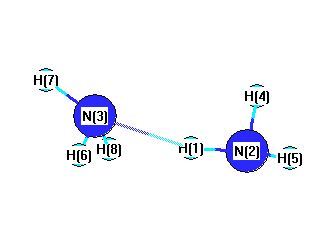Vibrational Frequencies calculated at HF_cp_opt/6-311+G(3df,2pd)
| Mode Number |
Symmetry |
Frequency
(cm-1) |
Scaled Frequency
(cm-1) |
IR Intensities
(km mol-1) |
Raman Act
(Å4/u) |
Dep P |
Dep U |
|---|
| 1 |
A' |
3814 |
3470 |
10.00 |
|
|
|
| 2 |
A' |
3803 |
3461 |
45.36 |
|
|
|
| 3 |
A' |
3691 |
3359 |
0.99 |
|
|
|
| 4 |
A' |
3682 |
3350 |
20.77 |
|
|
|
| 5 |
A' |
1790 |
1629 |
13.17 |
|
|
|
| 6 |
A' |
1783 |
1623 |
23.46 |
|
|
|
| 7 |
A' |
1129 |
1027 |
110.57 |
|
|
|
| 8 |
A' |
1121 |
1020 |
257.90 |
|
|
|
| 9 |
A' |
329 |
300 |
40.23 |
|
|
|
| 10 |
A' |
102 |
93 |
33.82 |
|
|
|
| 11 |
A' |
66 |
60 |
67.75 |
|
|
|
| 12 |
A" |
3816 |
3473 |
8.32 |
|
|
|
| 13 |
A" |
3814 |
3471 |
3.17 |
|
|
|
| 14 |
A" |
1805 |
1642 |
17.86 |
|
|
|
| 15 |
A" |
1788 |
1627 |
17.88 |
|
|
|
| 16 |
A" |
211 |
192 |
60.13 |
|
|
|
| 17 |
A" |
100 |
91 |
37.55 |
|
|
|
| 18 |
A" |
45 |
41 |
9.51 |
|
|
|
Unscaled Zero Point Vibrational Energy (zpe) 16444.3 cm
-1
Scaled (by 0.91) Zero Point Vibrational Energy (zpe) 14964.3 cm
-1
See section
III.C.1 List or set vibrational scaling factors
to change the scale factors used here.
See section
III.C.2
Calculate a vibrational scaling factor for a given set of molecules
to determine the least squares best scaling factor.
Charges, Dipole, Quadrupole and Polarizability
Charges from optimized geometry at HF_cp_opt/6-311+G(3df,2pd)
Charges (e)
| Number |
Element |
Mulliken |
CHELPG |
AIM |
ESP |
| 1 |
H |
0.000 |
|
|
|
| 2 |
N |
0.000 |
|
|
|
| 3 |
N |
-0.209 |
|
|
|
| 4 |
H |
0.000 |
|
|
|
| 5 |
H |
0.000 |
|
|
|
| 6 |
H |
0.070 |
|
|
|
| 7 |
H |
0.070 |
|
|
|
| 8 |
H |
0.070 |
|
|
|
Electric dipole moments
Electric dipole components in Debye
(What's a Debye? See section
VII.A.3)
| |
x |
y |
z |
Total |
| |
0.786 |
-1.893 |
0.000 |
2.050 |
| CHELPG |
|
|
|
|
| AIM |
|
|
|
|
| ESP |
|
|
|
|
Electric Quadrupole moment
Quadrupole components in D Å
| Primitive |
|---|
| | x | y | z |
|---|
| x |
-6.788 |
0.150 |
0.000 |
| y |
0.150 |
-3.612 |
0.000 |
| z |
0.000 |
0.000 |
-6.166 |
|
| Traceless |
|---|
| | x | y | z |
|---|
| x |
-1.899 |
0.150 |
0.000 |
| y |
0.150 |
2.865 |
0.000 |
| z |
0.000 |
0.000 |
-0.966 |
|
| Polar |
|---|
| 3z2-r2 | -1.932 |
|---|
| x2-y2 | -3.176 |
|---|
| xy | 0.150 |
|---|
| xz | 0.000 |
|---|
| yz | 0.000 |
|---|
|
Polarizabilities
Components of the polarizability tensor.
Units are
Å
3 (Angstrom cubed)
Change units.
| |
x |
y |
z |
| x |
1.732 |
0.044 |
0.000 |
| y |
0.044 |
1.785 |
0.000 |
| z |
0.000 |
0.000 |
1.706 |
<r2> (average value of r
2) Å
2
| <r2> |
78.572 |
| (<r2>)1/2 |
8.864 |
